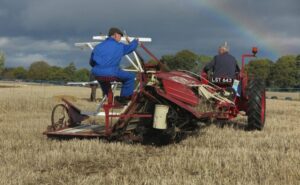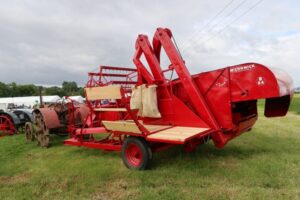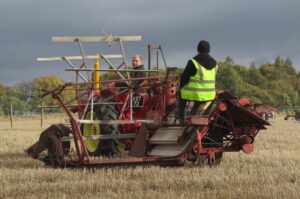At the time when combine harvesters were starting to be introduced in increasing numbers in the late 1940s, there was still a lot of debate over their use by comparison to the binder. An article in The Scotsman on 13 August 1948 noted a number of them. It captures very well the major changes that were taking place on the harvest field and also in grain handling. It is worth quoting at length:
“Serious problems of the harvest
“Combines” score in bad conditions
“When you think your barley is ready for cutting, go away and take a week’s holiday”, us an old and useful piece of farming lore, but there are seasons when it is difficult to follow such advice and this is likely to be one of them.
It is possible, in fact, that it may be nothing more than a race against time to get the crop in, whatever its state.
Sodden fields, as flat as if a road roller had been put over them, are already the heartbreaking experience in some areas where cutting could have been under way.
In spite of the present heavy setback by the weather and the fairly wide incidence of lodging in certain districts it is possible to express the cautious view that, with an early return of better conditions and a sustained period of reasonable weather, there will be a better grain crop-in the south-east of Scotland, at any rate-than there was last year. An improvement of 40 per cent in the oat and barley crops is the estimate of one authority. Last year the crop was, of course, very light, and it will not be difficult for this year’s to achieve much higher results.
Should the season stay bad those in the possession of combines will score-at least as far as harvesting is concerned, for combines will deal with laid crops far better than any binder. Before now a combine has saved a crop which would have been largely lost.
When to cut, depends of course on the crop. Barley must be dead ripe to achieve the best results both in the yield and in the keeping quality, for if the crop is fully matured on the stalk then a shower will dry out quickly. Oats may be cut with a touch of green. In other words, the crop, the method used in harvesting, and the weather are the deciding factors in assessing time to cut. It is not easy to decide, but farming is not an easy job, although some people seem to think so.
Combine development
A recent statistical report shows that there are 260 combined harvester-threshers in Scotland this year, which is 50 more than two years ago, and 160 more than in 1944.
While it is encouraging to think that such up-to-date methods of harvesting are being developed steadily it is well to remember that combines bring other problems in their trail, the chief among them being those concerned with the driving and storing grain harvested by these means.
The common method of harvesting by binder, stooking, and threshing, spreads the grain delivery over several months. The combine produces the grain in one operation. The merchants and the mills may not be able to deal with it all at once, and there may be allied problems of transport.
The fitness of the grain for storage depends on the moisture content. Barley should be brought down to 10 or 12 per cent, for safe storage, but should this season continue on its unhelpful way, the moisture content is going to be much higher. The brewers and distillers can take barley up to a certain content, but above the line the drying charges increase, and it may be a costly business before the grain is finally disposed of.
The question which arises is, therefore, are combines arriving faster than the facilities for dealing with the grain? The answer seems to be that in a bad, wet season, we have not the capacity for dealing with the crop, and one expert remarked in the course of a conversation the other day that the combines would “choke themselves”. There is already indication that drying facilities will be in demand this year, and one plant is now dealing with orders from firms who did not require these facilities before.
From this point of view, therefore, as well as from the general good and wellbeing of the farming community, we need a good long-term change in the weather.”


